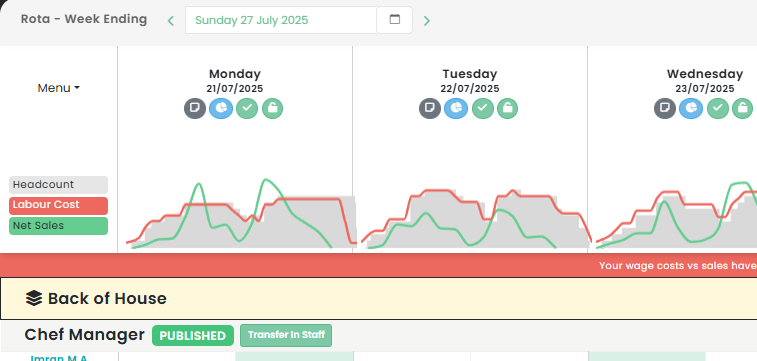Maximizing Your Earnings: Understanding and Improving Restaurant Profit Margin for a Successful Hospitality Business
Stay informed with industry news, tips, and practical guides for hospitality professionals.
What is a Good Profit Margin for a Restaurant?
Running a restaurant is a rewarding, albeit challenging venture. One of the pivotal concerns that every restaurateur grapples with is understanding the ideal restaurant profit margin. Achieving a profitable restaurant business depends on various factors, from effective cost management to driving restaurant revenue. This article explores these dynamics, providing insights into the restaurant industry profit margin and how to increase restaurant profits.
Understanding Restaurant Profit Margin
Restaurant profit margin is the measure of a restaurant's profitability. Essentially, it's the percentage of the restaurant revenue left after deducting all costs associated with running the business. In the UK hospitality industry, the standard restaurant profit margin may vary widely depending on multiple factors such as location, cuisine, service style, and business model.
Managing Restaurant Costs
Effective management of restaurant costs is critical for a successful restaurant business. These costs include food and beverage costs, labour, rent, utilities, and other operational expenses. By diligently tracking and managing these costs, restaurant owners can significantly improve their restaurant profitability.
Increasing Restaurant Profits
To increase restaurant profits, it is imperative to implement strategies that boost revenue and reduce costs. These may include menu engineering, upselling, controlling food waste, improving service efficiency, and employee training. Additionally, leveraging technology for inventory management, reservations, and online ordering can drive efficiencies and improve the bottom line.
Restaurant Revenue
Restaurant revenue is derived from food and beverage sales, and it serves as the lifeline of any restaurant business. Increasing this revenue involves attracting more customers, boosting average spend per customer, and promoting repeat business. Effective marketing, exceptional customer service, and a compelling menu are key to achieving these goals.
Profitable Restaurant Business
A profitable restaurant business is not solely about generating significant revenue; it's about maximising the restaurant profit margin. This involves enhancing operational efficiency, reducing waste, implementing effective financial management, and delivering exceptional value to customers. Restaurant owners must continually review and adjust their strategies to adapt to changing customer preferences, market trends, and business environments.
Restaurant Financial Management
Restaurant financial management plays a pivotal role in determining the restaurant profit percentage. It involves monitoring financial performance, budgeting, forecasting, cash flow management, and making informed financial decisions. By understanding and applying financial management principles, restaurant owners can ensure their business remains profitable in the long run.
Improving Restaurant Profits
Improving restaurant profits requires a strategic approach and a relentless focus on optimisation. It may involve renegotiating supplier contracts, redesigning the menu to highlight high-margin items, optimising staffing, or investing in energy-efficient equipment. The key is to identify areas of improvement and relentlessly pursue them.
Conclusion
In conclusion, a good restaurant profit margin is a result of effective operational, financial, and strategic management. By focusing on these areas, restaurant owners can ensure a successful and profitable restaurant business. The hospitality industry profits when restaurants thrive, contributing to the overall growth and vitality of the UK's vibrant and diverse culinary landscape.
Ready to simplify hospitality ops?
We’ve got you.
Speak with an Opsyte expert to see how we help:
- Save hours on staff scheduling and rota planning
- Automate invoice processing and financial insights
- Track live labour costs vs sales in real-time
- Get fast answers and support from real humans
- Automate your P&Ls

“Opsyte transformed our entire back office. Game changer.”
Read articles from our hospitality experts
-
Unveiling the Secrets to Successful Restaurant Business: Understanding Average Profit Margins and Boosting Restaurant Revenue
What is the Average Profit Margin for Restaurants?Understanding the average profit margin for restaurants is vital for anyone involved in the restaurant business. It provides a clear picture of the…...
-
Mastering the Art of Dining: Comprehensive Strategies to Improve Your Restaurant - From Management to Customer Service, Marketing and Beyond
How to Improve Your Restaurant: A Comprehensive GuideIn the highly competitive hospitality industry, improving your restaurant takes more than just a passion for food. It involves a careful balance of…...
-
Leveraging the QSR Industry: Understanding Fast Food Trends, Strategies, and Growth in the Hospitality Business
Understanding the QSR Industry in the UK Hospitality LandscapeThe Quick Service Restaurant (QSR) industry, commonly referred to as the fast food industry, is a significant component of the UK's hospitality…...
-
Maximising QSR Services: An Insight into Trends, Technology, and Growth Strategies in the Fast Food Industry
Embracing the Future of QSR Services in the UK: A Comprehensive AnalysisIn the ever-evolving landscape of the UK hospitality industry, Quick Service Restaurants (QSR services) have emerged as a pivotal…...
-
Unlocking the Secrets of Profitability: An In-depth Analysis of Average Restaurant Profit Margins in the Hospitality Industry
Understanding the Average Restaurant Profit Margin in the UK Hospitality IndustryThe restaurant industry forms a significant fraction of the UK's hospitality industry. As an industry that's intrinsically linked to consumer…...
-
Boosting Your Business: Innovative Bar Promotional Ideas and Marketing Strategies to Increase Sales and Traffic
10 Innovative Bar Promotional Ideas to Boost Your BusinessThe UK's hospitality industry is a vibrant and competitive space with bars and pubs at its heart. As a bar owner or…...
